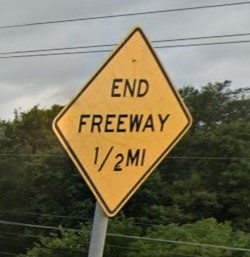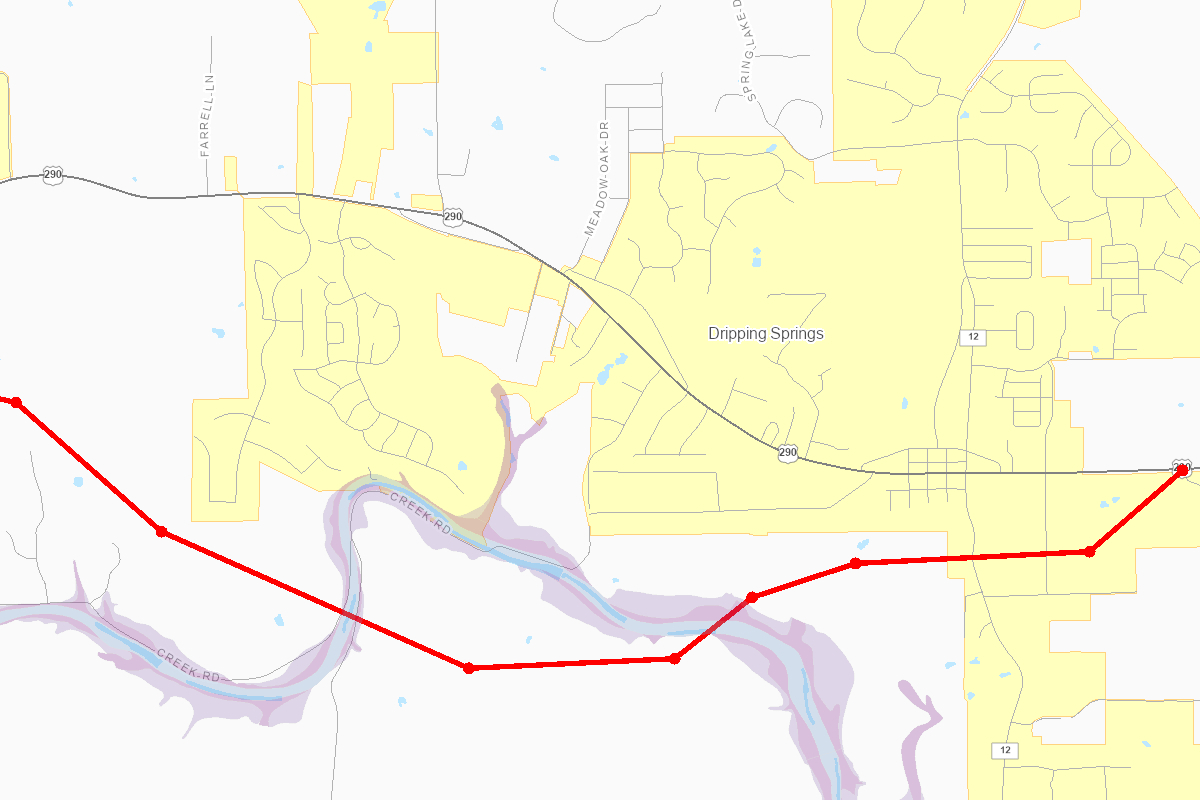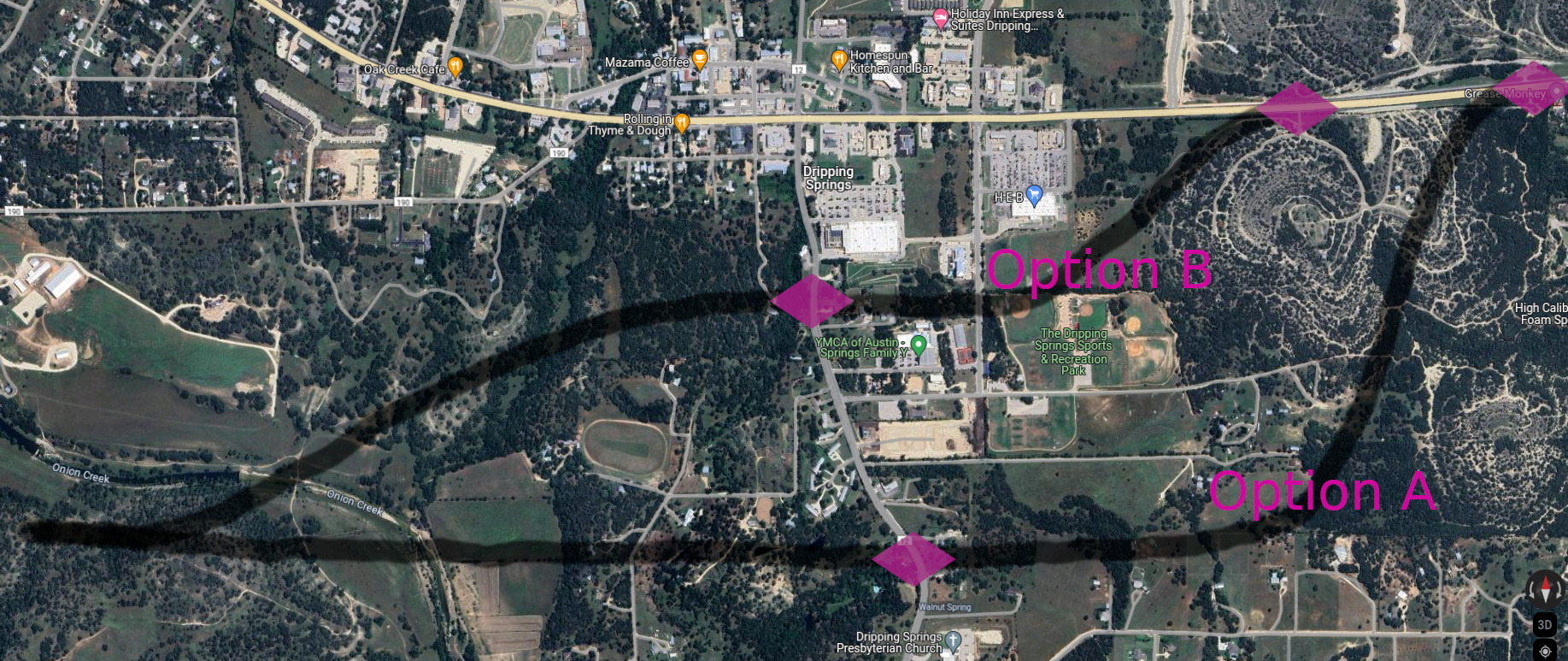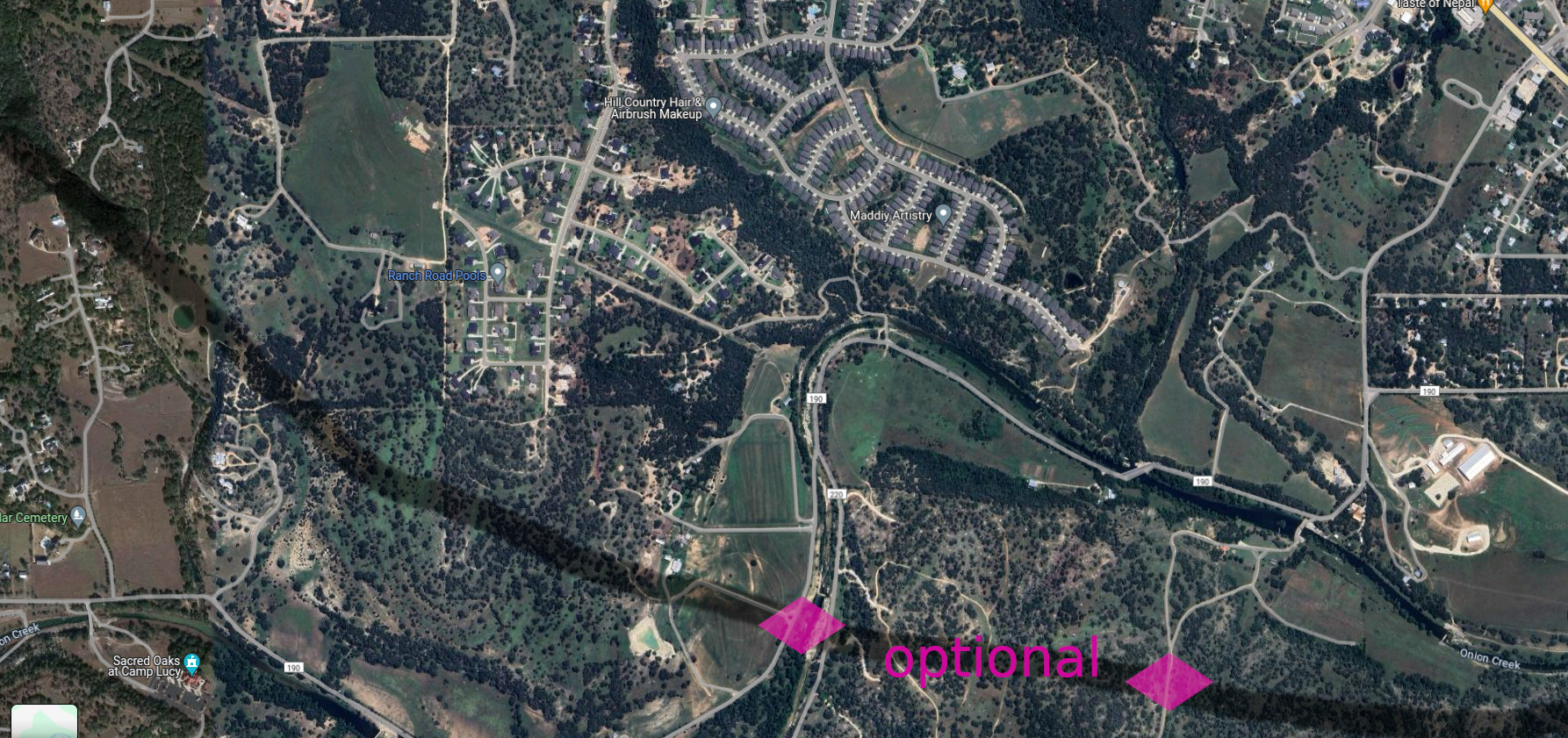Save
Dripping Springs!
(by
solving traffic issues with a common sense bypass)
TL;DR: Saving Dripping Springs is impossible.
TxDOT cannot build a freeway bypass without local government support
followed by years of studies and planning. Nothing below can be
built until after land owners and developers have covered all paths
with thousands of houses.
June 2024
(May 2025 – see NEW US
290 below for a bigger and better bypass – save more of DS!)
 Dripping
Springs at Ranch Road 12 will repeat the 40 year Oak Hill traffic
jam unless the freeway can end WEST of town. As US 290 is
the only route headed west from Austin, limited access freeway beyond
Dripping Springs is inevitable, it is only a matter of when. For
analysis of the current highway plan east of here see Fact
Check: US 290 from Oak Hill to Dripping Springs.
Dripping
Springs at Ranch Road 12 will repeat the 40 year Oak Hill traffic
jam unless the freeway can end WEST of town. As US 290 is
the only route headed west from Austin, limited access freeway beyond
Dripping Springs is inevitable, it is only a matter of when. For
analysis of the current highway plan east of here see Fact
Check: US 290 from Oak Hill to Dripping Springs.
 This
page is an idea to save downtown
Dripping Springs by moving through traffic around town rather than
through town. Let “Business 290” remain small and local – no
frontage roads!
This
page is an idea to save downtown
Dripping Springs by moving through traffic around town rather than
through town. Let “Business 290” remain small and local – no
frontage roads!
DISCLAIMER:
I am just a concerned resident, not a traffic engineer. If I drew a
line on your property I apologize. If this idea were to proceed, it
would be planned by professionals including environmental study,
public input meetings, detailed design and so on. If your idea is
better, please let me know!
Frontage
Roads Through Town!
Getting the freeway west of town
while keeping the current 1 US highway path through town requires
future frontage roads. This future expansion will remove all
structures within 150 feet
of the current 290 since it will need to be at least 321 feet wide.
Or perhaps it could go up in the air and hover over the frontage
roads to fit in the current space and save buildings.
Either way would be destructive
and would lose the small
town charm along current 290. The bright side is that historic Mercer
Street (the original 290) would survive US 290 frontage roads!
Current
Business 290 + New 290 Freeway Bypass
Many down town areas have been
saved by splitting the highway into separate local and through
routes. Examples include Brenham,
Taylor,
La
Grange and many others. Destructive widening through town is
eliminated when you
offload through freeway traffic around town. Frontage roads are not
needed on either path since the original business highway and its
cross streets already provide local access from nearby freeway exits.
Therefore the new freeway bypass can fit in less than 150 feet while
supporting up to 3 lanes in each direction. The new path also gives
locals more options for getting around town, further relieving
traffic in town and improving business access and quality of life.
Sadly, houses are already built
in all possible bypass paths or will be added in the next few years.
See below for other path ideas already blocked by houses. Shown here
could be the last remaining nearly
clear path to route through traffic as of 2024. If you wait to buy a
right of way, then freeway bypass
will become impossible and you will be forced to frontage roads
through town.
 East
End Option A
East
End Option A
This image is a detail of the east end
of the highway split. There are today two relatively clear paths to
an overpass that connects to RR12 south of business 290. Option A is
further out and south of YMCA which appears preferable. However, the
curves could be too tight and this space is already consumed by the
coming hundreds of houses of Village Grove. It is not likely this
could work. Therefore option A is not shown on the overall image
above.
East End Option B
Option B is closer in around only HEB.
This provides more gradual curves to the south and west. There is
about 300 feet between the Courtyard hotel and the YMCA. So the
minimum 120 feet required for the freeway can fit through to the RR12
overpass. Freeway would go ~20 feet elevated over Rob Shelton and
RR12 due to their close proximity but only RR12 needs ramps down to
the signal.
 Onion
Creek and Bridges
Onion
Creek and Bridges
Proceeding west, staying north of
Onion Creek would have been ideal with fewer bridges. But many houses
are already built in that path. So freeway must now cross the creek
twice, once in the above image and again in this one. This section
can optionally have on/off ramps to Creek Road and/or Roger Hanks for
another local access option. Only one of these is needed, not both.
The west end would continue on and
reconnect the highway split near Holder Lane.
Final Thoughts
As little as 150 feet right of way
would support up to 3 lanes in each direction and even SUP (shared
use path) for hiking and biking. Grass median instead of concrete
barrier would require at least 200 feet. Imagine how beautiful this
path would be when finished! Travelers would get to see more of the
beauty of this town through the hills and trees and even over the
creek. Truckers would no longer compete with locals in downtown.
Residents would have better mobility, no longer stuck at 290 and RR12
every day.
If similar right of way is not
obtained now,
freeway bypass becomes
impossible, see below. In
2025 this path affects < 25 properties
and < 6 structures. Imagine how many it will affect after the
land is sold to housing developers.
Please let TxDOT and your city
leaders know if you agree
with this idea or find a better way to save Dripping Springs from its
area growth and increasing
traffic. For example, you might also advocate the next idea:
 New
US 290 North - 30 mile Bypass Option!
New
US 290 North - 30 mile Bypass Option!
(This section added May 2025 thanks to
input from Miki Cook and other Neighbors!)
For an even better (or
additional) option, add limited access freeway along Robinson,
Pedernales Falls and Fitzhugh from Johnson City to SH 45 and Circle
Drive. Add interchanges to the cross roads. Widen at least McGregor
and RR 12 to handle crossover from new US 290 to current “Business
290”. This alignment at Johnson City shortens US 290 by 5 miles!
This would offload a large volume of through traffic from current 290
and resolve the escalating traffic problems along Fitzhugh. It would
also work beautifully with the future SH 45
west.
Footprint width and community impact
can be minimized if the freeway can be offset to the side of current
roads. Existing roads remain in place as-is providing continued local
access during and after construction. The opposite side might later
need similar nearby 2-way access roads. The draft idea shown here
tries to minimize roads and property affected by running south of
Robinson and north of Fitzhugh.
If offset is impossible, and this must
be built in current (but wider) right of way, then frontage roads may
be required to provide local access. I believe offset would look
better and be preferred over frontage roads in this “country”
area that is not high density city.
Conclusion and Background
Saving Dripping Springs is
impossible. TxDOT
cannot build a freeway bypass without local government support
followed by years of studies and planning. Nothing above can be
built until after land owners and developers have covered all paths
with thousands of houses. The only viable path for freeway is the
one place the highway already is: right through downtown.
For previous bypass ideas that
already fail to work and why, please see the original
version of this article from April 2024.
Tim Witham <twitham@sbcglobal.net>,
June 2024, updated May 2025
 Dripping
Springs at Ranch Road 12 will repeat the 40 year Oak Hill traffic
jam unless the freeway can end WEST of town. As US 290 is
the only route headed west from Austin, limited access freeway beyond
Dripping Springs is inevitable, it is only a matter of when. For
analysis of the current highway plan east of here see Fact
Check: US 290 from Oak Hill to Dripping Springs.
Dripping
Springs at Ranch Road 12 will repeat the 40 year Oak Hill traffic
jam unless the freeway can end WEST of town. As US 290 is
the only route headed west from Austin, limited access freeway beyond
Dripping Springs is inevitable, it is only a matter of when. For
analysis of the current highway plan east of here see Fact
Check: US 290 from Oak Hill to Dripping Springs.
 East
End Option A
East
End Option A Onion
Creek and Bridges
Onion
Creek and Bridges New
US 290 North - 30 mile Bypass Option!
New
US 290 North - 30 mile Bypass Option!